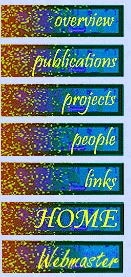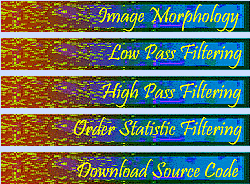|
Low pass filtering is a way of looking at image details that
do not change very quickly in a spatial sense. For example consider
an image of a black box on a white background. This image has
both low frequency (slowly changing areas) and high frequency
(fast changing areas). The low frequency areas are places such
as the middle of the box which is solid black, or the white background
which is solid white. In these areas a given pixel is surrounded
by pixels which are just like it. Hence they are low in frequency.
High frequency components in this image are the edges of the
box. The reason for this is if you examine a pixel on the edge
of the box it has neighbors which are not only not the same color,
but are at the extreme other end of the the intensity spectrum.
Now that we have identified a bit of what the low pass filter
is looking for we need to find a way to show low frequency information.
The easiest way to do this is to average a given pixel with its
neighbors. In the areas where there is not much change (such
as the middle of the box described earlier) the image remains
unchanged. However when we look at the borders of the box we
find that the image is now averaged between black and white,
producing gray. This means that the edge from black to white
is now longer because the border has black white and gray pixels
in it.
For this reason low pass filters (and
averaging filters in particular) are often known as blurring
filters. This is because is one takes a sharp, well focused image
and averages the pixels, the high frequency components (the edges of
the picture) will be smoothed out.
|





